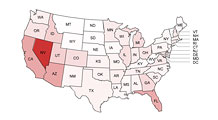 NYTimes | The first night after she surrendered her house to foreclosure, Sheri West endured the darkness in her Hyundai sedan. She parked in her old driveway, with her flower-print dresses and hats piled in boxes on the back seat, and three cherished houseplants on the floor. She used her backyard as a restroom.
NYTimes | The first night after she surrendered her house to foreclosure, Sheri West endured the darkness in her Hyundai sedan. She parked in her old driveway, with her flower-print dresses and hats piled in boxes on the back seat, and three cherished houseplants on the floor. She used her backyard as a restroom.The second night, she stayed with a friend, and so it continued for more than a year: Ms. West — mother of three grown children, grandmother to six and great-grandmother to one — passed months on the couches of friends and relatives, and in the front seat of her car.
But this fall, she exhausted all options. She had once owned and overseen a group home for homeless people. Now, she succumbed to that status herself, checking in to a shelter.
“No one could have told me that in a million years: I’d wake up in a homeless shelter,” she said. “I had a house for homeless people. Now, I’m homeless.”
Growing numbers of Americans who have lost houses to foreclosure are landing in homeless shelters, according to social service groups and a recent report by a coalition of housing advocates.
Only three years ago, foreclosure was rarely a factor in how people became homeless. But among the homeless people that social service agencies have helped over the last year, an average of 10 percent lost homes to foreclosure, according to “Foreclosure to Homelessness 2009,” a survey produced by the National Coalition for the Homeless and six other advocacy groups.
In the Midwest, foreclosure played a role for 15 percent of newly homeless people, according to the survey, reflecting soaring rates of unemployment — Ohio’s reached 10.8 percent in August — and aggressive lending to people with damaged credit.

















